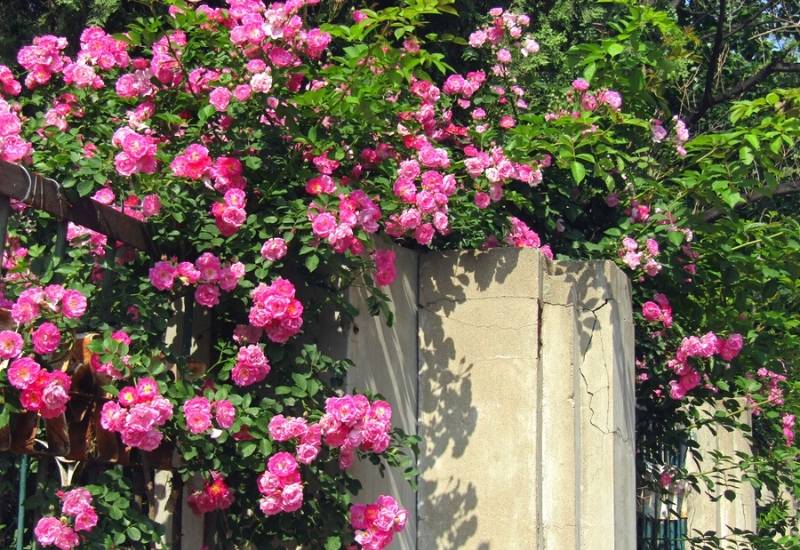
Growing fragrant and colorful roses that climb over gates, gazebos and pergolas can turn any garden into a little piece of heaven. Close your eyes and imagine them in that sunny green spot you had in mind… I know why you want one now!
But we all know the truth: roses are not low maintenance, and they are quite fussy and delicate. However, climbing roses are delicate plants that need a lot of care and attention, while providing a rich bounty in return.
Climbing roses need specific planting and growing methods, including fertilizing, support, prune and protection from disease and pests. “Rose gardening” is a whole specialized craft. But with the right care, you can enjoy their amazing blooms from May to September!
Follow along with this guide to learn more about how to give your climbing roses the best care possible to ensure that you get abundance of blooms for many years.
These tips are guaranteed to make sure they grow well and produce plenty of flowers all summer long.
Why Do Rose Climb?
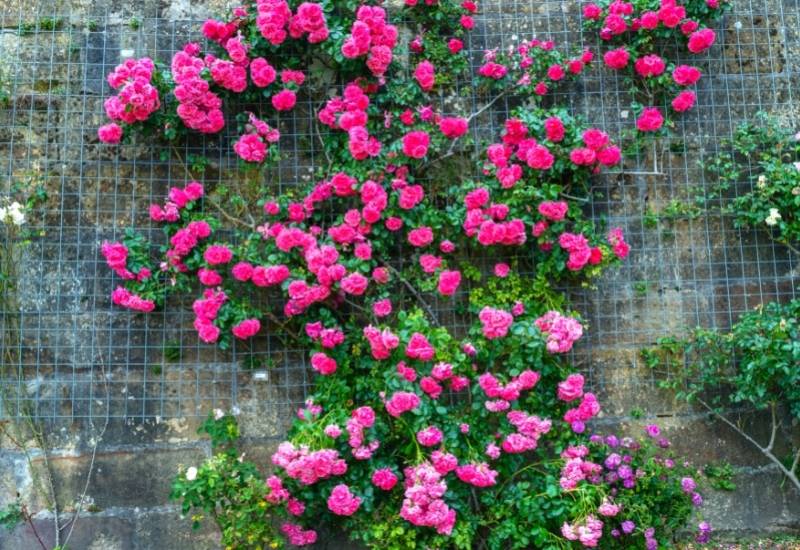
The answer is simple: rose don’t climb! Ok, we started well, did we? Roses are not actual climbers, they are shrubs. But some species in nature grow over other bushes, like bramble.
If you take a walk in the countryside in a fresh and temperate area, you will see any of the many species of dog roses (Rosa canina) or prairie rose (Risa setigera) and similar varieties that arch over large bushes to get the best of the sunlight.
These grow very long stems, and they can be trained to “climb”. They have no tendrils and they don’t twine, so you need to attach them to a support, like a trellis, fence, a gazebo etc..
If you don’t they will just grow long arching branches that fall back towards the ground.
So, a climbing rose is a shrub that has learned to climb with your help…
And they do need quite a bit of care and training.
The Do and Don’ts Of Planting a Climbing Rose
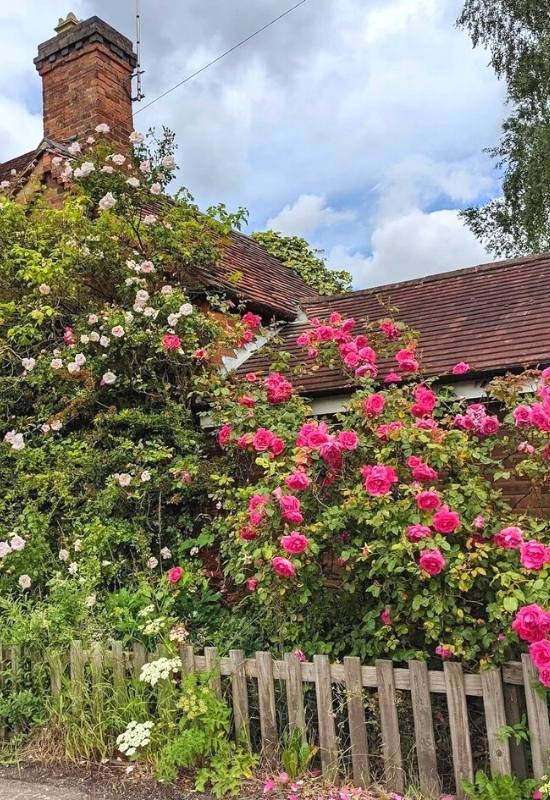
Soil, sunlight and place are key to your climbing rose’s happiness. Do not underrate this point. The wrong place and soil and your rose will never, never be strong and healthy, no matter what you do late on.
You must have seen roses that “look ill and sad” with small blooms, dried petals, sick leaves… The chances are that the place is just not right.
To start with… the don’ts:
Now the dos, and some are already clear from the don’ts.
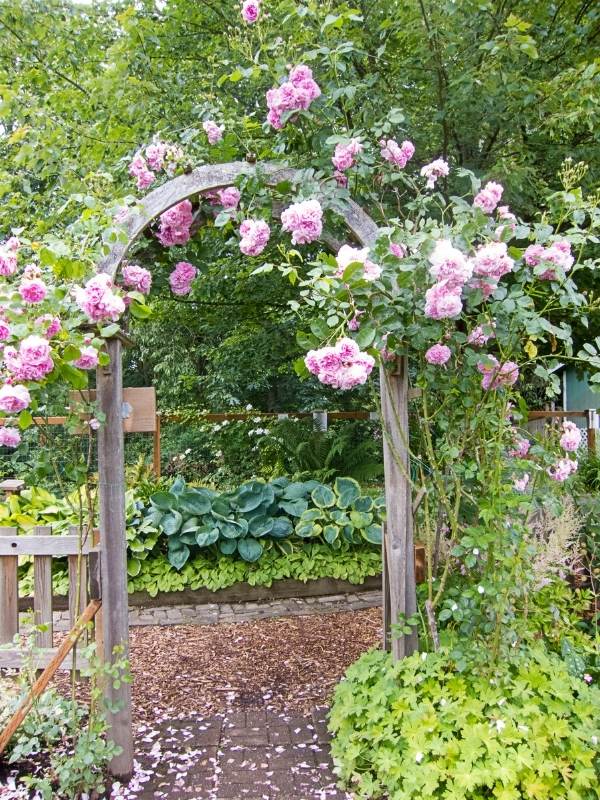
It’s not easy to find the right place for a climbing rose, as you can see. But id you do that, you will really start off on the right foot and give your flowering climber a great start in life!
Now we need to get into the specific of the soil.
Where to Plant a Climbing Rose
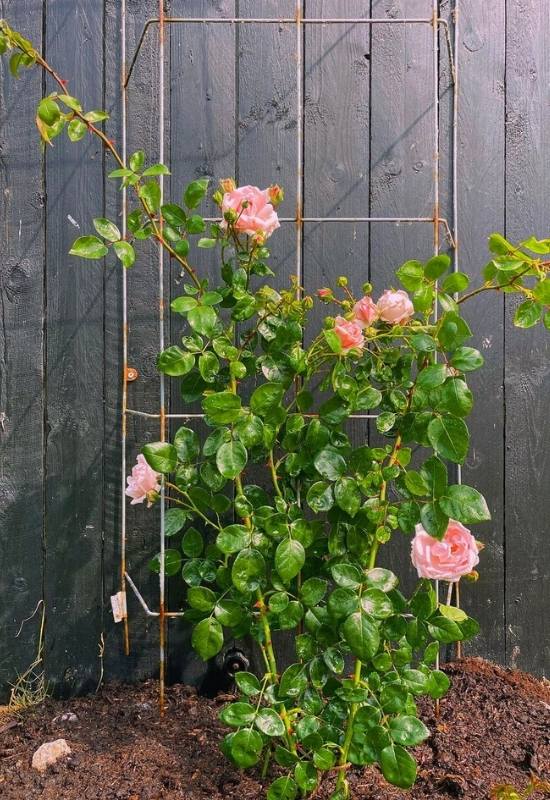
Roses are adaptable to different soil types, but they are also picky – let me explain…
Climbing roses prefer loamy soil, but they adapt to clay, sand and even chalk based soil. They can even thrive in clay soil, if is rich and well drained. This makes them “easy going” in a way, few plants actually stand chalk, but…
The soil needs to be balanced; they will not grow in heavy clay, hard chalk or very sandy soil. If this is the case in your garden, improve the soil.
Next, roses need rich soil, by this we mean rich in organic matter and nutrients.
And of course roses need very well drained soil.
Finally, the ideal rose pH for roses is between 6.0 and 6.5, so mildly acidic, neutral is fine but anything past mildly alkaline can be a problem. So if the soil pH is above 7.5, lower it.
Even soil that’s top acidic is bad for roses because they won’t have access to potassium, nitrogen and phosphorus, so, no soil under 6.0.
To make things simple, the soil pH for roses can go from mildly acidic to mildly alkaline with a preference for mildly acidic. In numbers: 6.0 to 7.5 in range and 6.0 to 6.5 as ideal pH.
If you like organic gardening, roses want healthy and living soil. This means soil rich in bacteria, michorizza, and small animals (worms etc.) that “work” the soil for you.
Well done! And now you know all about “where”, we can start with “when”.
When to Plant Your Climbing Rose
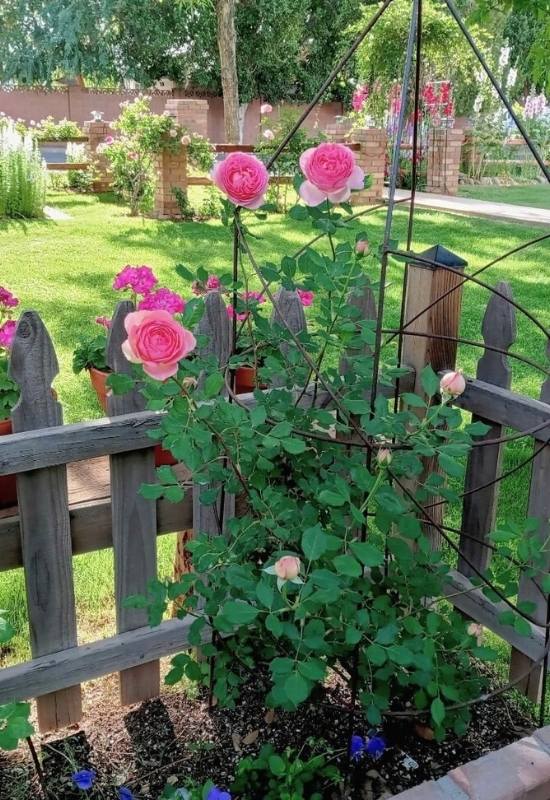
Go to a garden center and you will find roses ready to plant any season. But this does not mean that you can plant them at any time! On the contrary. If you buy a rose in a pot in winter, you will have to shelter it in its container till spring.
The ideal time to plant climbing roses in in fall. Long before frost though! You will need to give your rose time to settle in before the temperatures drop to freezing. If you plant your rose in fall, mulch abundantly. This will keep the roots warm through its first winter.
You can plant roses in spring, but make sure frost is no longer possible. If you plant them in spring, they will be “behind” compared to fall. Planting roses in fall means they will start growing early in spring. If you plant them in spring, they will stop growing branches for some time while they establish their root system. They may not even bloom for some months…
Can you plant roses in summer? Ideally you should never plant roses in summer but you can in an emergency. Be particularly careful if the weather is very hot; most roses are not heat tolerant. Planting them in summer in a very warm region can spell disaster and give your rose massive stress.
Can you plant roses in winter? Forget it in most regions. If there is any risk of frost, you may lose your plant altogether.
Now you know the “when”, it’s time to look at “how”.
How to Choose a Climbing Rose to Plant
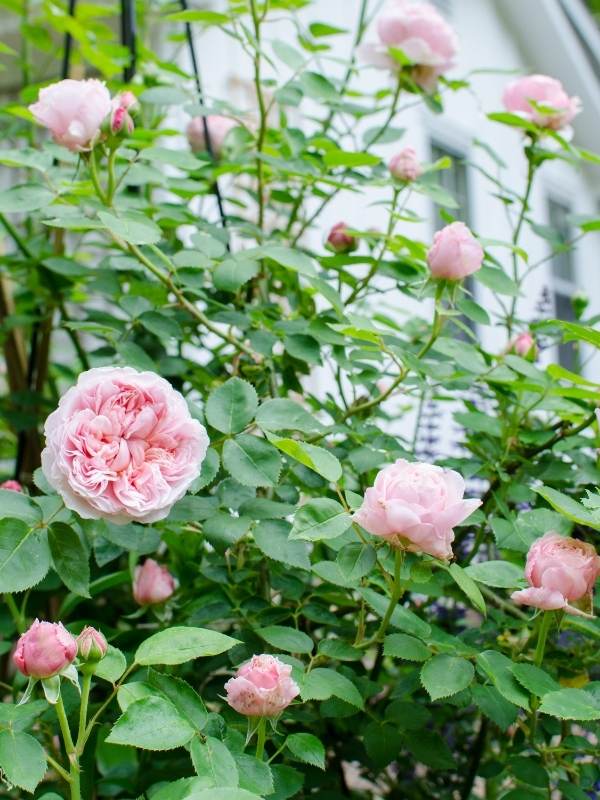
Apart from choosing the variety you like, you need to choose a healthy plant.
How to Plant a Climbing Rose
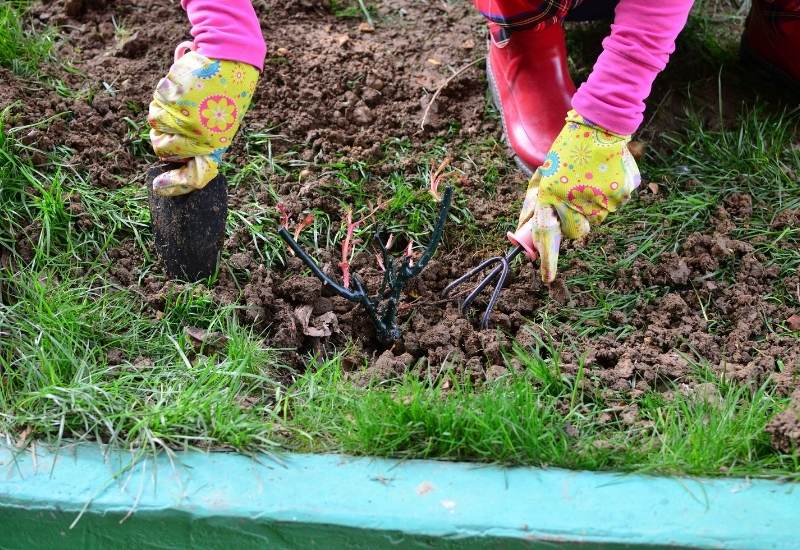
Roses want to find a comfortable “home” when you plant them, and your job is to provide it! You will need to make sure the soil is fertile and well drained, as we said… Then…
Now the “home” is ready…
One note… Plant your rose in the evening!!! Don’t do it in the morning or when the Sun is high. Plants have an active metabolism during the day, and a slower one at night. Give your climber time to rest, just like you do after a journey, it makes sense, doesn’t it?
In the next few days, check that the soil is getting form but not compact. In case you see that it’s sinking too much, add some of the same soil, drainage and compost mix and press down.
Finally, mulch abundantly! Do it as soon as the soil has settled, not as soon as you plant them. It may be on day two or three or maximum within a week. Do it even in spring, even if it’s less necessary than in fall. Mulching always keeps the climate underground stable, and this is what the roots need to settle in.
How to Take Care of Climbing Roses
Planting a rose is a real specialized job as you can see… as is growing it, as you will see…
Provide Strong Support From The Very Beginning
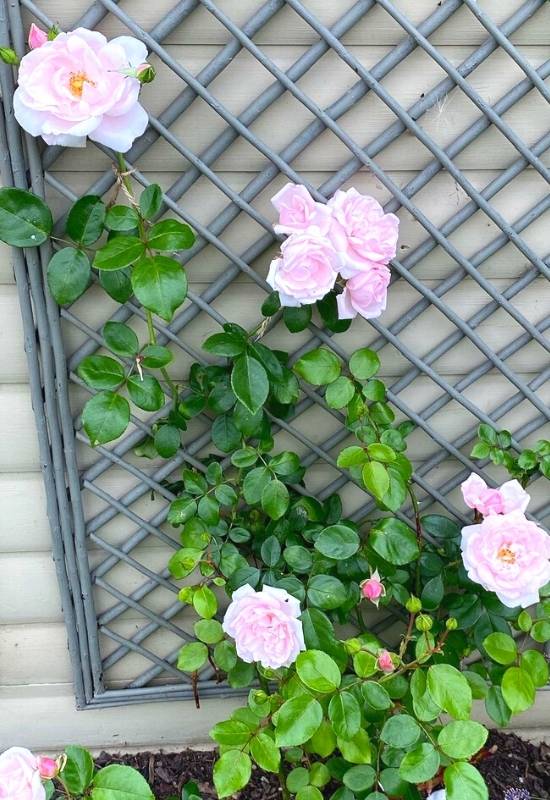
The first thing to keep in mind to plan and build the support for your rose to climb is that it must be strong and durable! Roses are heavy (!!!) and they can live for decades! You can’t change the support while the rose is growing; you would need to cut it back completely!
So, if you use wood, make sure it is treated and durable. Iron will rust unless you teary it. Even concrete is not that durable at all…
Make sure the support is steady in the ground. You need to plant it deep. It really depends on your situation how you go about it. If you plant wood posts in the ground,
they need to be “sealed” (with pitch traditionally) or they will rot. Some people even like the post to be in a hole filled with concrete, so it is more stable.
Loamy and sandy soil requires more depth than clay soil.
The type of support depends on your taste and needs: a trellis, pergola, arbor, gazebo, gate, fence, porch… but not all climbing roses are suitable for columns! They need to have special qualities like long and flexible stems… Do check in the plant description; it will tell you.
Finally, place the support very close to the rose! Maximum 1 foot away (30 cm).
Now you have the right support it’s time you become a “teacher” for your rose.
Train Your Climbing Rose Plant On Structures
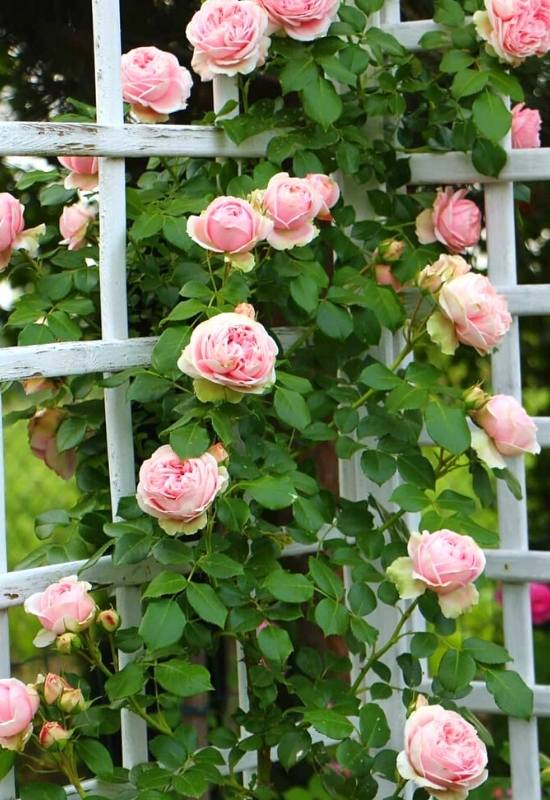
Your rose will need some encouragement to climb. Natural climbers find the support on their own and they cling to it or wind around it. Roses cannot “see” the support. You will have to “show it to them”.
You need to take the chosen branch, lead it to the support and fasten it gently. You can use any string, but ideally plastic zip ties are perfect. They are durable, they don’t rot and they don’t rust. Wire can actually damage the rose stem, so avoid it.
Most importantly, keep the fastening very loose and large! Allow the room your rise need to grow, or you will end up cutting it. What you need 4 or even 5 inches in diameter (10 to 12.5 cm).
Shape Your Climbing Rose
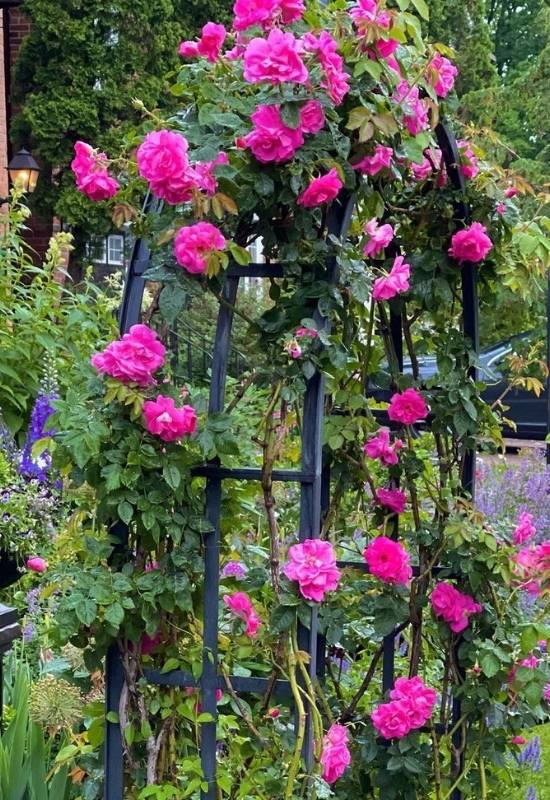
You decode what your climbing rose needs to look lie and you will have lots of branches to choose from for this. To start with, it’s time to get technical…
In a climbing rose, “branches” are called “canes” .
There are main canes, that start from the base of the plant and lateral or secondary canes that grow from them.
If you leave all the main canes, you will get a thick rose; it will form a “green wall” that fills with beautiful flowers.
But you may want to have a lighter effect, where you can through the rose. In this case, you will want to select a few main canes and prune the others from the base.
Even in a “full green wall effect” you may have far too many main canes. In either case, always select the canes that are stronger, healthier and more vigorous.
You will attach the main canes to the support, and leave the secondary ones free. This will allow you to determine the overall shape of the climbing rose. You can make it arch, for example, or zig zag, or you can get canes to intersect etc.
Try to allow the main canes to grow. You should never deadhead the main cane! That would stop its growth….
When the rose becomes big, it may be hard to recognize main canes from lateral ones; as a tip, mark your main canes with colored and loosely tied ribbons.
Now, you can see that lots of it has to do with pruning, and pruning roses is an art!
Know When to Prune Your Climbing Rose
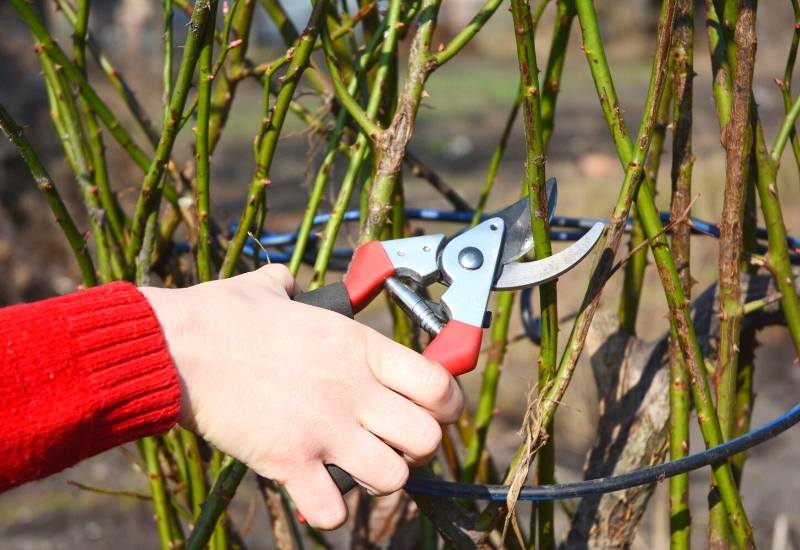
“Prune your climbing roses when forsythia is in bloom,” gardeners say. It’s an excellent rule of thumb, but in general, the idea is that you need to prune roses early in spring, just before the new gems start growing. They will be there but still dormant.
This is the main pruning, which means the “shaping” of the plant for the year (and beyond).
You can cut dry, dead and sick canes and branches at any time. Actually do keep an eye out for them.
You may want to clean off all sick material in fall. Dry stems may not be a problem, but sick ones may spread disease. And you will improve ventilation.
Deadheading is not pruning and you’ll do it after the blooms are spent.
Like with all “when’s” even this is followed by a “how”.
How to Prune a Climbing Rose
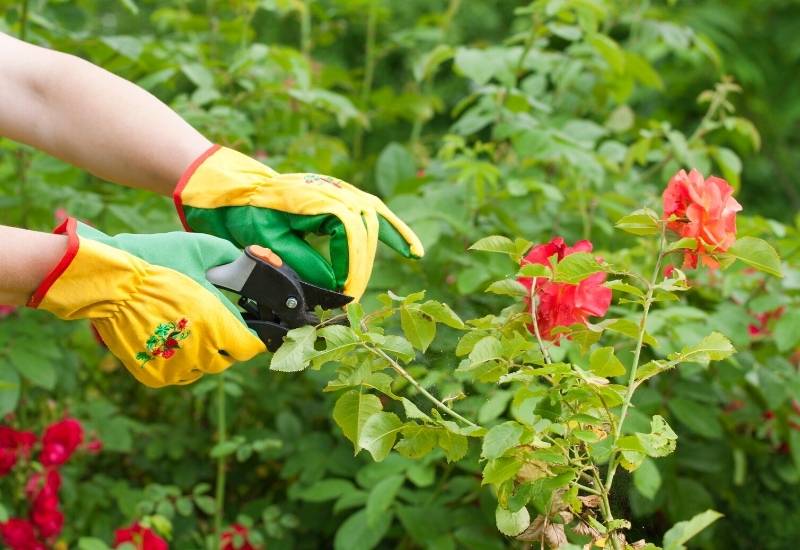
Pruning a climbing rose is different from a shrub rose. With a shrub rose, you want to keep a few low woody branches and push all the new ones out, “like a basket”, we say. But this is not the case with a climbing rose.
The most important pruning for a climbing rose is the first, the “shaping” as we say. It is when you choose which main canes you will keep. Unlike for a shrub rose, where you can it back the main branches each year, for a climbing rose these will have to keep growing. Do once you choose them, it’s “for life”.
You can cut a main cane if:
All the rest of the pruning for climbing roses is to secondary, or lateral canes.
For these:
You will see that over time, you will cut off the older, lower lateral canes. You can select higher lateral canes to arch down and cover the empty spaces that these leave, if you want your blooms to start low down.
Safety Measures to Prune a Climbing Rose
Pruning can be a source of danger and disease for all plants, especially roses. There are some key safety measures to use when you prune them…
I forgot your safety: wear gloves, because roses have thorns!
Deadhead a Climbing Rose To Encourage More Flowers Later
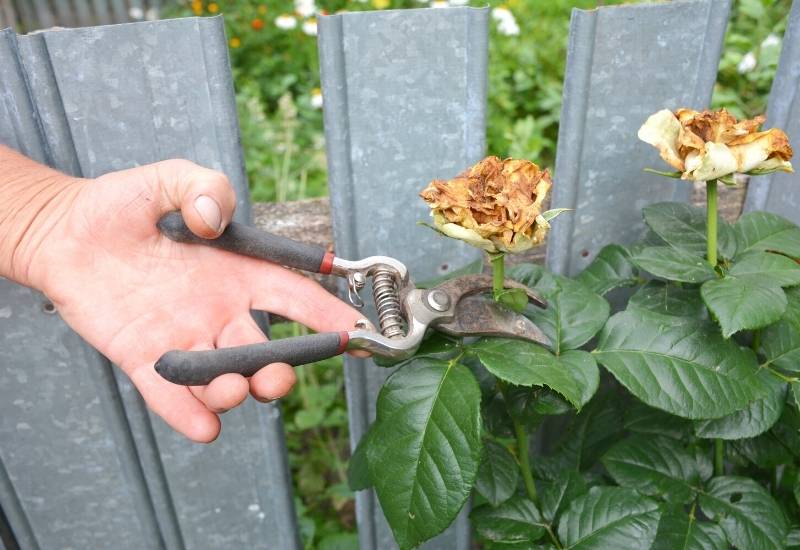
Climbing roses have long repeated blooms that can go from May to September only if you deadhead spent flowers. Deadheading a rose is a form of art (too)!
First, sterilize the blade. Second, look down from the spent bloom and find the first leaf with 5 leaflets! Not 3!!! This is the secret. If you cut above a three leaflet leaf, the stem will dry up and die! If you cut above a five leaflet one, it will survive and give new blooms.
Really keep this in mind because it can make all the difference between a wonderful rose that blooms all the season and one that looks sad and empty for most of it.
Cut (at an angle) about one inch above the leaf.
While you are at it, you can choose which way you want your cane / branch to develop. The new shoot will grow in the direction of the leaf or gem you have selected as last. This way you can train the rose to go one way or another.
Rose gems and leaves are alternate, not opposite. One goes one way and the next the opposite way. If the 1st leaf with 5 leaflets goes the the wrong way, the way you don’t want it to grow,choose the next one down and it will go the other way!
I told you that growing roses is an art! You see I was right?
How to Water Climbing Roses
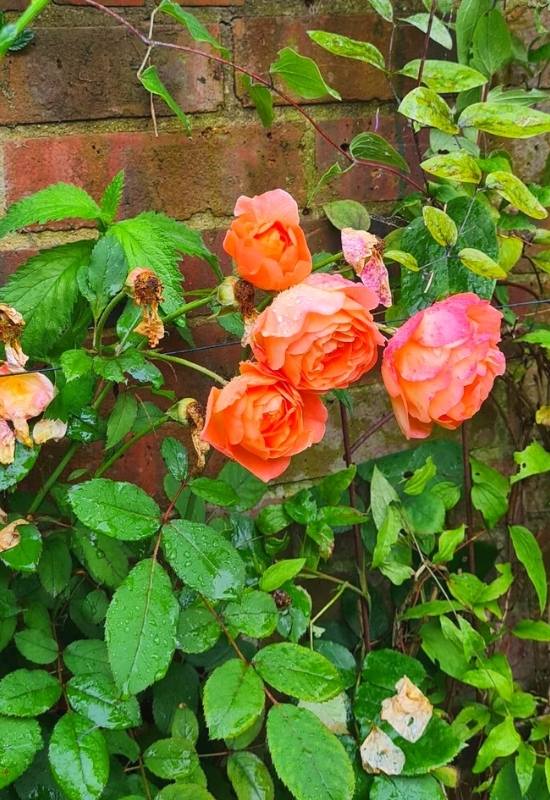
Roses need plenty of water. You will need to water regularly and abundantly, especially in summer! This will help your rise tolerate the heat, while in winter you can suspend watering if you live in a wet winter region.
From spring to fall, a rose may need 4 to 5 gallons of water a week. This is a rough estimate, and lots depends on the climate. Just to give you an idea.
As usual, with watering use your judgement. If winters are dry, do give the occasional watering, but don’t overdo it.
Do not overwater. Do not leave the soil waterlogged. If you can, also avoid pockets of water near the base of the rose. These can literally cause the plant to rot, especially in spring, fall and winter.
Do not water if you expect frost and freezing temperatures! That can make things worse, as the water may freeze under the ground and even damage your plant. In winter, roses sleep, they need a dry, fresh and healthy environment with just a tiny bit of water to “wet their mouths”.
When to Feed a Climbing Rose
Feed your climbing rose regularly. It depends on how fertile the soil is… Ok, let’s get real…
In a naturally healthy setting, you may even need to feed your rose once a year, if at all. This is in permaculture or other advanced organic gardening methods.
But most gardens are not at that stage of soil health. In most gardens, there are some important feeding times you can’t miss.
Then there’s the “on average” rule… the less experienced one will find on plant guidelines. This too really depends on the climate, soil fertility etc. but, “on average”…
This gives you an overall idea of the feeding progress all year round. If your soil I healthy and fertile, you can reduce feeding. On the contrary, you will want to feed more often or more generously if your soil is poor in nutrients.
How and What to Feed Your Climbing Roses
Always use an organic fertilizer. This is the key rule. To be honest few professional gardeners use chemical fertilizers nowadays, and even fewer when it comes to roses. They are use in intensive and extensive cultures, like for cut roses, but hardly for gardens.
Any complete, rich and fully mature compost based fertilizer will do for routine feeding. But you can use organic liquid fertilizer if you need quick release and absorption of nutrients. Basically, if you see your plant is “starving” or if it’s had stress and you want to give it a quick boost, use nettle water or any similar liquid fertilizer.
Amateurs swear by used coffee grounds (nit fresh!) and banana peels scattered on the ground.
I would suggest rose specific organic fertilizers if you don’t have a compost heap. There are loads on the market, and they are designed specifically for the most loved flower in the whole world.
The NPK ratio for roses is usually 4-6-4 or 4-8-4. However, you can find similar ones too (low concentrations like 3-2-4). Phosphorus rich fertilizers can help you if the blooms are disappointing. In fact, this element boots flowering.
Finally, give the dried leaves back to the rose… When leaves drop, they are meant to feed the soil, and any plant’s own dry leaves are the best way to feed the soil with what the need…
Climbing Roses and Disease
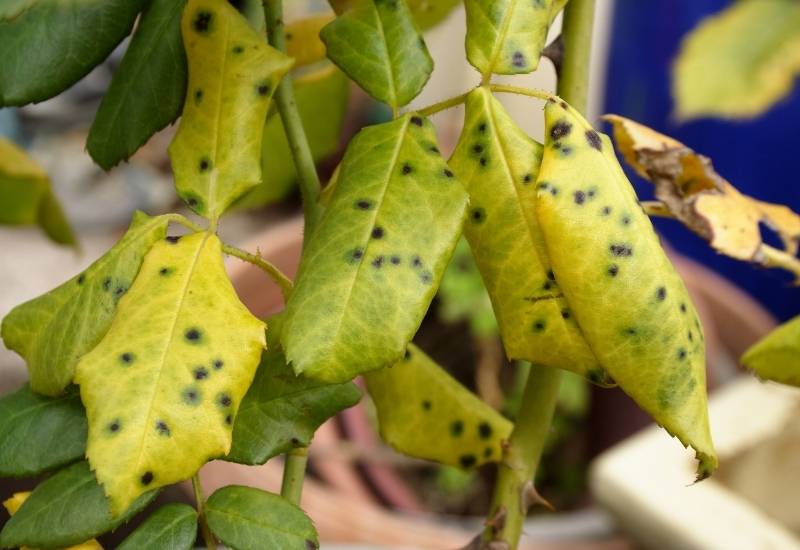
Roses are disease prone, whether they climb or they stay as shrubs. Some varieties are healthier than others, especially natural species. Many cultivars are quite weak, but not all of them…
Don’t panic if your rose has some disease! It’s very common and in many cases, your plant will manage pretty well. Take a walk around your neighbors’ gardens and I bet you’ll find it hard to see a single rose with no disease at all!
The problem is when the ailment gets out of control or when several complaints happen at the same time. But don’t beat yourself up if this happens; I have seen a rose in a famous park with 5 different ailments! So it happens even to professionals then!
Let’s see some of the most common next and what to do…
Always Check the Leaves of Your Rose!
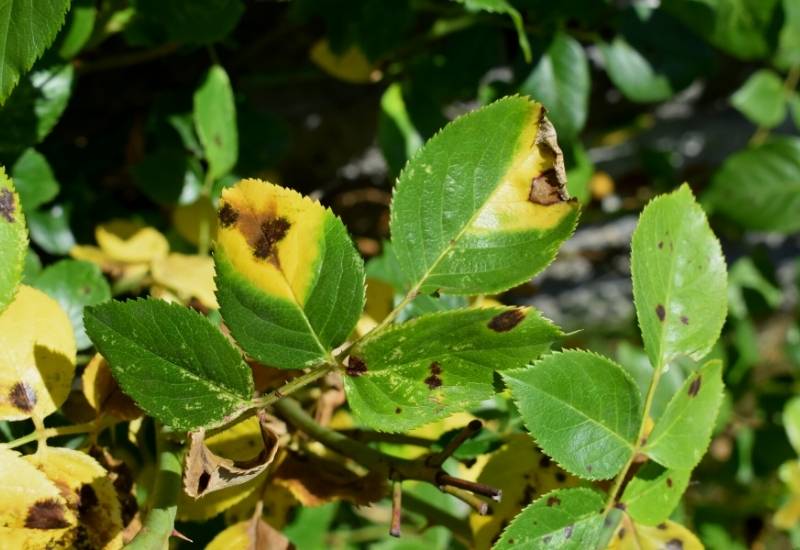
Rose leaves get ill very easily; they are an indicator of the overall health of the plant. Some leaf disease is normal, even expected on a rose plant, but keep an eye on it – if it increases, then your green companion is getting worse.
Rose Leaf Spot and How to Treat It
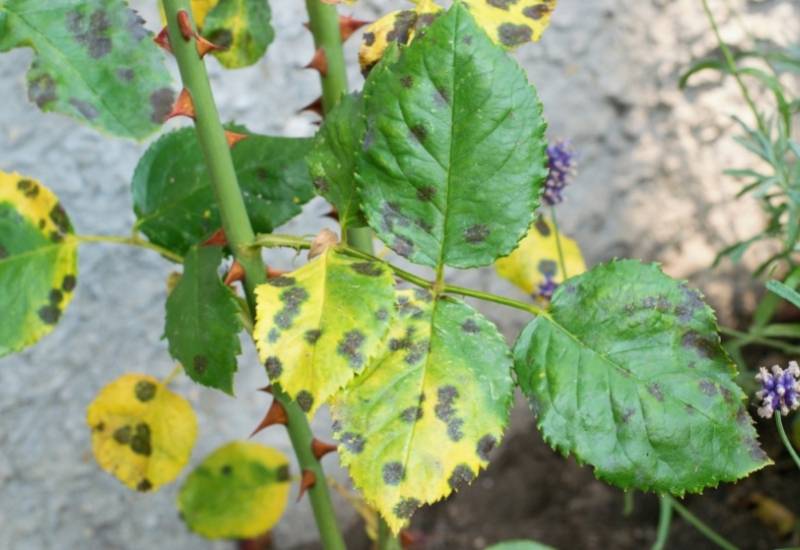
Rose leaf spot is caused by a fungus called Diplocarpon rosae. It is very common and you will notice it because the leaves get dark, almost black spots. Then they turn yellow and they die. When it gets bad, it can be a serious problem for your rose.
To start with, the problem may be the environment. Excessive humidity and lack of ventilation are often the causes. You may want to prune the rose to give it some fresh air…
To treat rose leaf spot spray leaves with neem oil. Do it in the evening because it can burn your leaves in the Sun. Repeat as necessary.
Rose Rust and How to Treat It
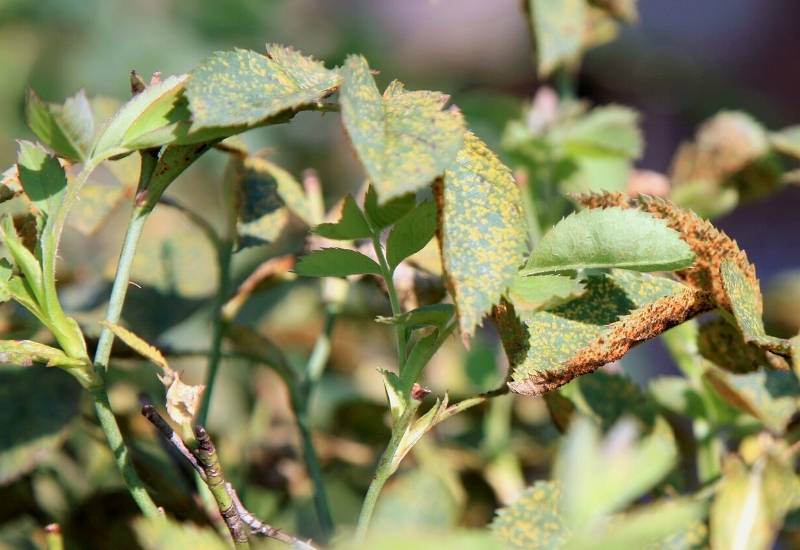
Rose rust is another common leaf problem… You will notice red spots on the leaf that look like rust. It is caused by a fungus called Phragmidium tuberculatum or related species.
It is not as serious as rose leaf spots and it’s very common especially in spring and summer. The leaves will drop in the long run but the plant will not suffer excessively.
Spray neem oil on the plant to treat rose rust. Again, do it in the evenings and repeat as necessary.
Powdery Mildew and How to Treat It
Powdery mildew appears as a white powder on leaves, petioles, stems and sometimes up to the flowers. It is caused by a fungus called Podosphaera pannosa. It is caused by excessive humidity, and it’s common when and where summer and fall are wet.
You can treat powdery mildew by spraying neem oil on the plant. Again, do it in the evenings as neem oil can burn the leaves of your rose in the Sun. You will also want to prune excessively hit branches.
Rose Leaf Spot, Rose Rust and Powdery Mildew: How to Stop Them Spreading
You will notice that these fungal diseases spread and tend to stay in your garden and on your roses for long, even years. Collect the affected leaves and branches you have pruned, or those that have died and burn them! If you leave them on the ground or near the plants they will spore and spread back to your prized climbers!
Do not put affected leaves in the compost heap. You risk spreading the diseases to more and more plants. Only very experienced compost experts know how to avoid it…
Green Flies (Aphids) and How to Treat Them
Aphids, or green flies, love roses? You will find them on almost every rose in the world… A few won’t actually damage your rose, but they reproduce fast and when there are many, they will weaken your rose. Typical consequences are lesser blooms, slower growth etc.
You know things are bad when you look under the flower heads and they are packed. You know things are worrying when you see flower heads bend. That’s because aphids are sucking so much of the sap from your plant that it cannot keep the stem straight!
Aphids are naturally controlled by predators like ladybugs and other beetles. They really are great at that. So next year try to encourage them into your garden. But for the time being…
Repeat every two weeks and every time it rains. And don’t worry about the smell; it will disappear within a day from spraying and your roses will be as fragrant as ever!
Rose Stem Canker and How to Treat It
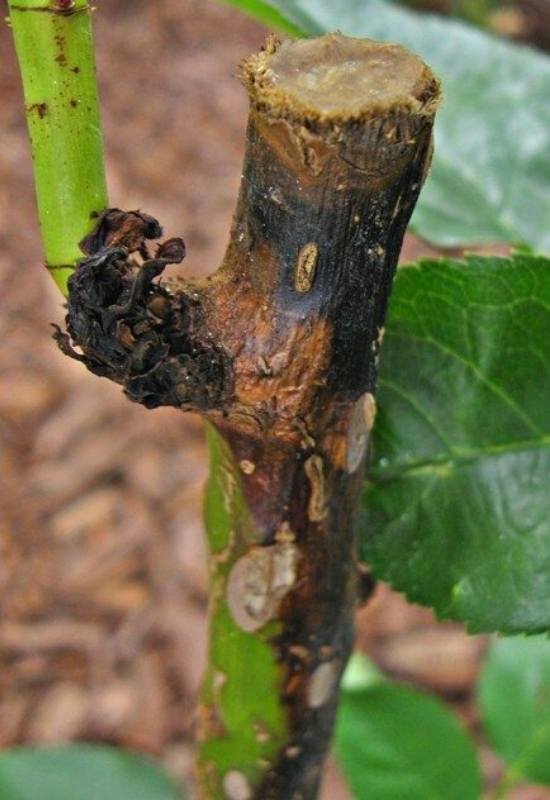
Rose stem canker appears as black stems, or canes, or very dark brown. It often affects a cut cane or a young cane from top to a node.
It too is caused by a fungus, actually a whole genus of fungi called Coniothyrium spp. These enter the plant through cuts, like when you prune them or if a cane breaks.
To treat rose stem canker take sterile blades and remove the whole part. Make sure you go past the affected area. Then spray neem oil on the wound and on the cane to stop it from spreading.
Again, burn the diseased parts.
Rose Cane Scarring and How to Treat It
Rose cane or stem scarring is common; it shows like brownish gray scars along the canes pr stems of your rose. In most cases it is not threatening in itself, but it weakens the plant and it gives points if access to pathogens like fungi.
It is cause by the thorns of the rose! When the canes move in the wind, they end up cutting each other. To avoid it, prune your rose so that the canes do not rub, and fasten the canes to the support carefully.
If a cane is so damaged that it’s almost breaking, cut it.
For extra safety, you may wish to spray a natural fungicide, like neem oil, over badly affected plants.
Now You Are a Real Climbing Rose Expert!
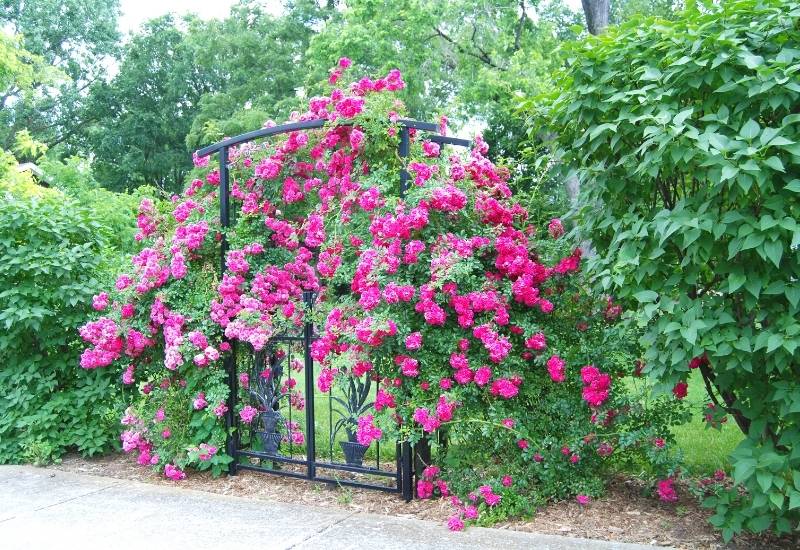
I told you that there was a lot to learn about climbing roses! Now you will agree that it’s a whole trade, a discipline or even an art! Thank for staying with me all this time and I hope you have learned a lot.
Of course you can’t remember everything right now, but as I said… bookmark this page and I’ll be here to help you every time you need me!

Written By
Adriano Bulla
After many years as an academic in London, Adriano Bulla became a writer, publishing books like A History of Gardening, Organic Gardening and Elements of Garden Design; he then decided to become a gardener, following his childhood dream, and has been following his dream writing and gardening professionally in Southern Europe, where he has specialized in new and innovative organic gardening fields and techniques, like permaculture, regenerative agriculture, food forests and hydroponics.

Terrific! Thank you.